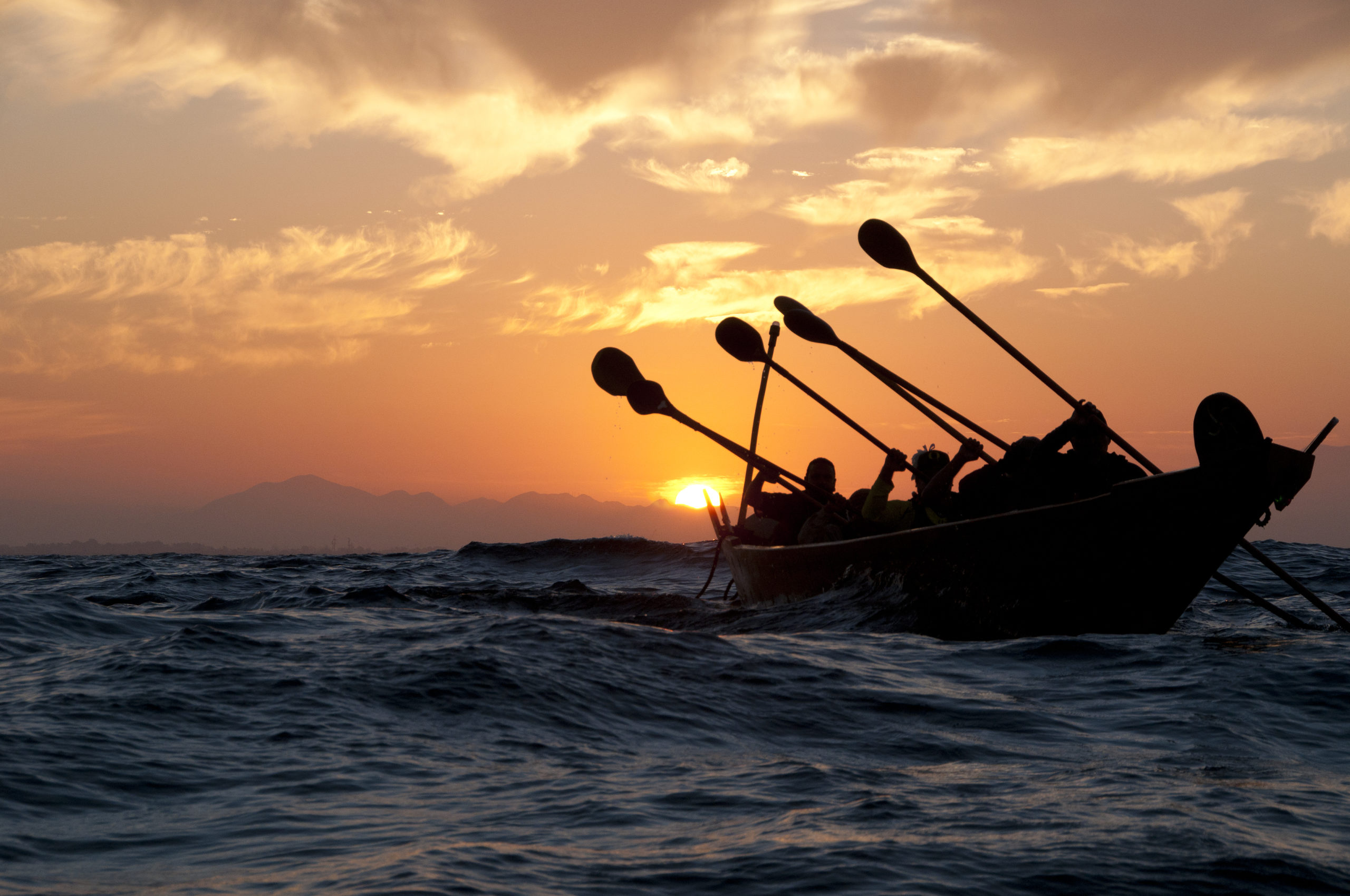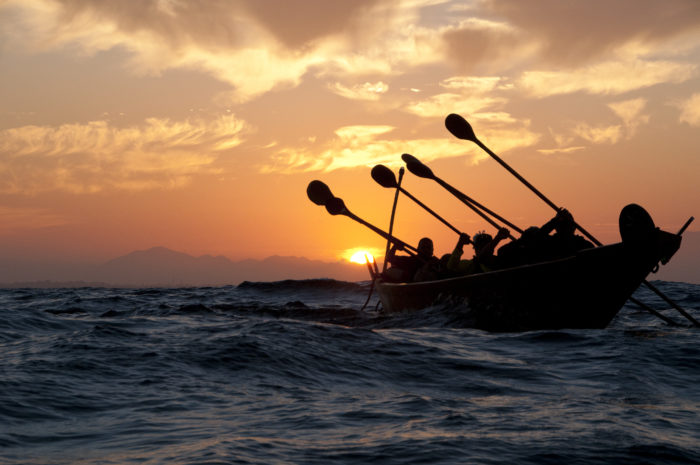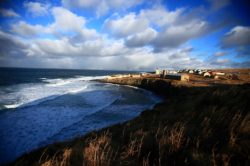
Blue Beacon: Embracing Collaborative Conservation in Future Sanctuaries

A traditional Chumash tomol crossing at sunset. Photo credit: Robert Schwemmer/NOAA
On Friday, October 1st, our ocean lost a true champion. Fred Collins, Northern Chumash Tribal Council Chair, who championed the designation of a Chumash Heritage National Marine Sanctuary passed away. We are saddened that Chair Collins and Mayor Pletnikoff of St. George, Alaska did not live to see the Biden-Harris Administration recognize their vision for ocean protection. We urge the Biden-Harris Administration to take action immediately to move forward with designation of the Chumash Heritage and St. George-Unangan national marine sanctuaries. Sincerely, Kris Sarri
The traditional ecological knowledge and wisdom of Indigenous communities deepens our understanding of the environment, improves decision-making processes, and strengthens collaborative management. National marine sanctuaries can serve as models for how collaborative development and management can work in marine protected areas. On September 21, the National Marine Sanctuary Foundation convened a panel of Indigenous leaders from Papahānaumokuākea Marine National Monument, and the proposed Chumash Heritage National Marine Sanctuary and the proposed St George Unangan Heritage National Marine Sanctuary to share their wisdom about how strong ties to culture and community are crucial for protection of our special marine places, and the role of their communities in collaborative conservation, as part of the ongoing Blue Beacon Series.
Speakers included Kalani Quiocho, Cultural Resources Coordinator, Pacific Islands Region, NOAA Office of National Marine Sanctuaries; Brad Kaʻaleleo Wong, Kūkulu Papahānaumokuākea Program Specialist, Office of Hawaiian Affairs; and Violet Sage Walker, Vice Chairwoman of the Northern Chumash Tribal Council. George Pletnikoff, brother of the late Patrick Pletnikoff, Mayor of St. George Island, joined the event to give a moving tribute to his brother.

Kalani Quiocho looks to the future of Papahānaumokuākea Marine National Monument. Photo credit: Nick Zachar
Papahānaumokuākea Marine National Monument is one of the largest marine conservation areas in the world, but what sets it apart most is how culture and nature are inextricably linked in its management framework. Kalani Quiocho noted that “we acknowledge this as a place where nature and culture are one.” Papahānaumokuākea has a unique co-management structure, with four Co-Trustees: the Department of Commerce, the Department of the Interior, the State of Hawaiʻi, and the Office of Hawaiian Affairs. These co-managers are guided by a mission of “seamless integrated management to ensure ecological integrity and achieve strong, long-term protection and perpetuation of Northwestern Hawaiian ecosystems, Native Hawaiian culture, and heritage resources for current and future generations.” Brad Kaʻaleleo Wong emphasized that these “relationships were key in establishing Papahānaumokuākea.” Developing relationships based on respect took time, and required building compassion, empathy, and trust. A historic guidance document, Mai Ka Pō Mai, established a new approach for collaborative management, grounded in Hawaiian culture. “Mai Ka Pō Mai helps demonstrate that native Hawaiian voices are given equal footing with federal and state entities in the management structure – and that it can help lead to successful management of protected areas,” says Brad.
Efforts are underway to designate Papahānaumokuākea Marine National Monument as a National Marine Sanctuary. As Brad, Kalani, and the many other Indigenous leaders and co-managers look to the future of Papahānaumokuākea, they envision the continuation of this collaborative process which will uplift Native Hawaiian voices and culture in a way that continues to be meaningful and relevant, not just for Hawaiʻi, but also for other marine protected areas. “Traditional ecological knowledge can be a best management practice that can be replicated elsewhere,” says Brad Kaʻaleleo Wong. The inclusion of Native Hawaiian cultural and conservation principles in the management of Papahānaumokuākea has inspired the prioritization of indigenous heritage in proposed national marine sanctuaries, such as the proposed Chumash Heritage National Marine Sanctuary and St George Unangan National Marine Sanctuary.

Violet Sage Walker gazes out into the waters of the proposed Chumash Heritage National Marine Sanctuary. Photo credit: Jeremy Bishop
The proposed Chumash Heritage National Marine Sanctuary is over a hundred-mile stretch of ocean along the central California coastline, nestled between Monterey Bay National Marine Sanctuary to the north, and Channel Islands National Marine Sanctuary to the south. Violet Sage Walker, Vice Chairwoman of the Northern Chumash Tribal Council, said, ”There are examples of tribal and Indigenous co-management at other sanctuaries and other marine protected areas… but the thing that is so special about this sanctuary is that it’s the first sanctuary that’s actually proposed by a tribe.” Preservation of indigenous culture will be a core value of the proposed Chumash Heritage National Marine Sanctuary. The identity of the Chumash people is deeply connected with their ancestry as seafaring people, and many sacred sites lie submerged within the proposed sanctuary. This proposed sanctuary would help strengthen the bonds between the Chumash people as they come together to celebrate their heritage, centered around the ocean. Says Violet, “the ocean has brought our people and our culture back together. That’s what the Chumash heritage is all about- bringing back our people, our songs, our gatherings, our stories, our art, and our history.”

A view of the coastline of St. George Island. Photo credit: Joe Connolly
This summer, we lost Mayor Patrick Pletnikoff, who was an incredible champion for the proposed St. George Unangan Heritage National Marine Sanctuary. The National Marine Sanctuary Foundation would like to express our deepest condolences to Patrick’s family, friends, and community for their loss. We were honored to be joined by Patrick’s brother, George Pletnikoff, to remember his life and legacy during this Blue Beacon event. Says George, “Patrick accomplished much, benefiting our Unangan people. Now at the cusp of almost five years of planning, working, and hoping, we are at the doorstep of a designation.” The proposed St. George Unangan Heritage National Marine Sanctuary would be Alaska’s first National Marine Sanctuary, and would safeguard the heritage of the Unangan people and the biodiversity found in and around these waters. George painted a picture of life on St. George Island, “a small little island in the middle of the Bering Sea”, which was once abundant with the song of seabirds and fur seals raising their young on the rocky shores. Patrick and other members of the city council of their village witnessed the decline of these species and the impacts of climate change, and together proposed this area for National Marine Sanctuary designation. Says George, “a sanctuary would give relief to our dwindling wildlife, and provide the means for our community to participate in and have a meaningful decision to do such.”
This was the third virtual event in 2021 of the Foundation’s Blue Beacon Series, a set of panel discussions, lectures, roundtables and film screenings which bring to light the pressing issues facing our ocean and great lakes. This year’s Series events focus on the role of people as stewards of our blue planet. We hope you will join us in December for the next Blue Beacon Series event, as we dive into the cultural significance of the humpback whale for Native Hawaiian people, and how this guides innovative approaches in whale conservation.
